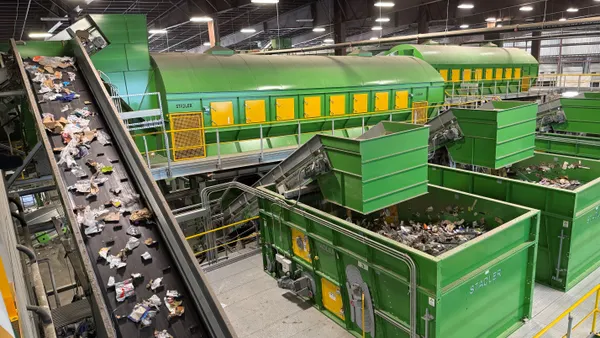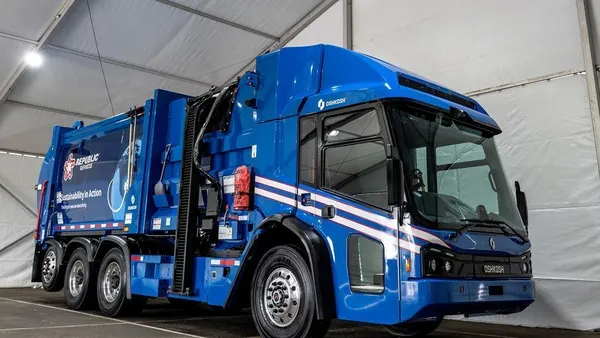Editor's Note: This viewpoint piece was written by Ted Onufrak, executive director of Centre County Recycling & Refuse Authority in Bellefonte, PA. The opinions represented in this piece are independent of Waste Dive's views.
Throughout 2016, numerous articles concerning the promises and pitfalls of recycling efforts across the country have graced my computer screen. CEOs and other upper management folks stating things have to change; markets need to improve; the focus must shift to “other” materials and everyone keeps searching to create a better wheel. One thing that certainly does seem to change is the headlines — the articles essentially carry the same story, but the authors create a better headline to make readers believe they’ve found a new wheel.
A recent article on the 2016 State of Curbside Report stated that "among communities that recovered over 400 pounds per household, 96% used single-stream collection. Carts were used in 83% of these programs." There is no mention of the contamination rates of the study participants, nor the average cost for single-stream versus the collection methods they replaced, but they readily point out the average disposal cost for municipal waste. Not long after, another article states that Chicago’s "blue cart" system is failing. Where’s this new wheel that claims this recently created phenomena called "single-stream" is driving recycling to all-time highs? Were the engine blocks and bowling balls in the blue cart system counted towards the 400-plus pounds per household?
If there is anything that all these articles (whether you call them blue cart or single-stream) agree upon, it’s the need for a “beefed up” education program. As if someone has determined that those of us currently performing education programs are failing and are the real cause for increased contamination. After over 25 years in this business I never really realized I have to educate people that engine blocks and bowling balls don’t belong in carts or bins. Is this the new expectation of those who clamor for more education? It seems that educational efforts are being graded upon contamination rates — which aren’t really due to lack of education, but often times due to the collection method. These "easy" ways to recycle are easy because you can contaminate without fear of being caught. Around my workplace, we call that "wishcycling."
"It seems that educational efforts are being graded upon contamination rates — which aren’t really due to lack of education, but often times due to the collection method."

Ted Onufrak
Executive Director, Centre County Recycling & Refuse Authority
I've yet to see any articles on the impact of single-stream recycling on pay-as-you-throw programs. A number of municipalities in my county have a “low usage” refuse rate which allows only one bag per week. Single-stream, with its high contamination rates, would seem to cause an increase in single bag customers. It simply shifts the disposal cost to the MRF instead of the refuse hauler.
The best method of education is on the job training. Source separated recycling at the curb provides that education day in and day out — to every customer, every collection day. One doesn’t need to hope the customer reads the newsletter or the directions they’ve been given. Besides the hands-on experience the customer gets, there’s also an element of peer pressure. When residents return home, they readily recognize the upside down collection bins, which mean everything placed in them was recyclable – and those residents whose bins are right side up now know their neighbors are aware they put something in the bin that wasn’t recyclable. And the collection personnel also need to learn what is recyclable and what isn’t, since they perform the curbside sort. The source separated collection method is a complete educational process for customers and employees and provides nearly a zero contamination rate that results in a higher quality product for markets and allows for more materials to be collected (like glass), which equate to increased revenues, than the wishcycling method.
Many of these single-stream concepts really seem to be promotional efforts by certain aspects of the waste and recycling industry. More automation creates more contamination which results in more waste for landfills. Bigger carts cost more than smaller bins and need more maintenance. Increased education costs typically fall on the government entities mandated to conduct the programs, not on the private sector companies often performing the task. It is interesting how the markets don’t seem to be driving collection methods, but rather the collectors blaming the lack of education and poor markets for collection costs and/or changes, like dropping glass from recycling programs.
Hence, my wish list for 2017 and a few New Year’s resolutions thrown in for good measure:
- I wish someone would do a carbon footprint study on collection methods in a place like Houston. While glass has been dropped from curbside collection, the collector is placing drop-off boxes for residents to take their glass. If it’s more economical for homeowners to drive their glass to collection centers, why not have them drive all their recyclables to a collection center and drop curbside collection altogether? This new "two component" system doesn’t seem "easier" or economical to me.
- I wish the glass industry would go on the offensive and start telling the public that there is nothing wrong with the glass market. Although it’s certainly not the most profitable recyclable, markets are strong and will most likely continue to be strong. In the 29 years my Authority has been collecting glass (currently about 2,500 tons per year) we have never had a load rejected. It’s not the material that’s a problem; it’s the collection method.
- I wish certain breweries would quit making aluminum beer cans with plastic CO2 cartridges inside the can. We did have a load of aluminum rejected because one bale contained 6 of these beer cans. Of course, with a source separated collection program we can resolve that problem via education of our customers and employees. How will automation solve that?
- I wish that those who continue to write survey stories on how many municipal programs they surveyed or studied would also report the total number of residences served by those programs.
- I wish the authors of these surveys would try harder to put their survey results in a format customers could relate to. There have been several articles this past year about waste haulers being caught landfilling recyclables. With single-stream contamination rates of 15-30%, that’s like dumping the recyclables of two out of every 10 households in the refuse truck. Are we saying that’s an acceptable way of conducting business? If so, then let’s just provide service to 80% of the households.
- I wish the plastics market would pay by volume rather than weight and that they would emulate the metal markets by developing a plastics crusher so they wouldn’t take up so much space in our curbside bins.
Some New Year's resolutions:
- I resolve to be continually grateful to our Authority customers that average 491 pounds of recyclables per household per year from our source separated collection program.
- I resolve not to mandate our education programs list bowling balls as an unacceptable recyclable.
- I resolve to continue our source separated residential curbside collection program for 28,000 households.
- And yes, we will continue to take glass.













